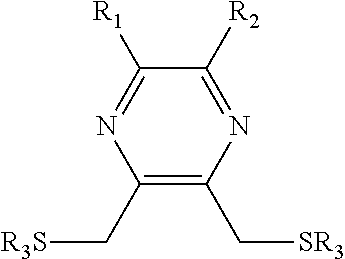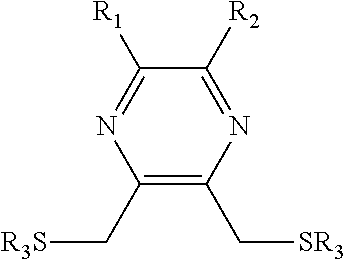Substituted pyrazine dithiol reducing agents
a technology of pyrazine dithiol and reducing agent, which is applied in the direction of enzymology, organic chemistry, transferases, etc., can solve the problems of preventing the ability of the molecule to reduce certain disulfides, dtt has a serious limitation, etc., to prevent the formation of disulfide bonds, reduce disulfide bonds, and prevent the inactivation of a given protein
- Summary
- Abstract
- Description
- Claims
- Application Information
AI Technical Summary
Benefits of technology
Problems solved by technology
Method used
Image
Examples
example 1
[0169]Commercial reagents were used without further purification. Dithiothreitol (DTT) was from Research Products International (Mt. Prospect, Ill.). Papain (lyophilized powder from papaya latex), creatine kinase (lyophilized powder from rabbit muscle), hexokinase (lyophilized powder from Saccharomyces cerevisiae), glucose-6-phosphate dehydrogenase (ammonium sulfate suspension from baker's yeast), Nα-benzoyl-L-arginine-4-nitroanilide hydrochloride, S-methyl methanethiosulfonate, trans-4,5-di hydroxy-1,2-dithiane (oxidized DTT), 2-mercaptoethanol, oxidized 2-mercaptoethanol, and 2-butyne-1,4-diol were from Sigma-Aldrich (St. Louis, Mo.). DTBA and oxidized DTBA were synthesized as described previously. [23]
[0170]All glassware was oven or flame-dried, and reactions were performed under N2(g) unless stated otherwise. Dichloromethane was dried over a column of alumina. Triethylamine and dimethylformamide (DMF) were dried over a column of alumina and purified further by passage through an...
example 2
Exemplary Chemical synthesis
[0174]
[0175]Compound 2 was synthesized as described previously from 2,3-dimethylpyrazine (1) resulting in comparable yields and identical NMR spectra [37].
[0176]1H NMR (400 MHz, CDCl3) δ=8.43 (s, 2H), 4.65 (s, 4H); 13C NMR (125 MHz, CDCl3)=151.4, 143.9, 29.5.
[0177]A flame-dried round-bottom flask was charged with 2 (0.907 g, 3.411 mmol), dissolved with 35 mL of dichloromethane, and placed under an atmosphere of dry N2(g). Triethylamine (1.50 mL, 10.76 mmol) and thioacetic acid (AcSH, 0.54 mL, 7.56 mmol) were then added, and the resulting solution was stirred overnight. After 16 h, the reaction was concentrated under reduced pressure and the resulting residue was purified by column chromatography (40% v / v ethyl acetate in hexanes) resulting in 3 (0.664 g, 76%).
[0178]1H NMR (400 MHz, CDCl3) δ5=8.42 (s, 2H), 4.43 (s, 4H), 2.39 (s, 6H); 13C NMR (100 MHz, CDCl3) δ=194.4, 151.1, 142.8, 32.4, 30.2; HRMS (ESI) calculated for [C10H13N2O2S2]+ (M+H+) requires m / z=25...
example 3
Determination of Thiol pKa Values
[0183]The thiol pKa values are determined by following a procedure reported previously that exploits the elevated absorbance of the deprotonated thiolate at 238 nm. [27, 28, 23] A plot of A238 vs pH was recorded (FIGS. 4A and 4B), and pKa values were determined by fitting these data to eq 1, which is derived from Beer's law and the definition of the acid dissociation constant [38].
A238=CT(ɛS-S-10(pH-pKa2)+ɛSHS-+ɛSHSH10(pKa1-pH)10(pH-pKa2)+1+10(pKa1-pH))(1)
[0184]For BMMP determination, in eq 1, CT is the total thiol concentration, εSHSH is the extinction coefficient of the doubly protonated form of BMMP, εSHS− is the extinction coefficient of the singly protonated form of BMMP, and εS−S− is the extinction coefficient of the doubly deprotonated form of BMMP. FIG. 4A illustrates the effect of pH on absorbance by BMMP at 238 nm in a 0.10 M potassium phosphate buffer. pKa values of 7.6±0.1 and 9.0±0.1, and extinction coefficients of εSHSH=5.24, εSHS−=3058...
PUM
| Property | Measurement | Unit |
|---|---|---|
| Biological properties | aaaaa | aaaaa |
| Time | aaaaa | aaaaa |
Abstract
Description
Claims
Application Information
 Login to View More
Login to View More - R&D
- Intellectual Property
- Life Sciences
- Materials
- Tech Scout
- Unparalleled Data Quality
- Higher Quality Content
- 60% Fewer Hallucinations
Browse by: Latest US Patents, China's latest patents, Technical Efficacy Thesaurus, Application Domain, Technology Topic, Popular Technical Reports.
© 2025 PatSnap. All rights reserved.Legal|Privacy policy|Modern Slavery Act Transparency Statement|Sitemap|About US| Contact US: help@patsnap.com



